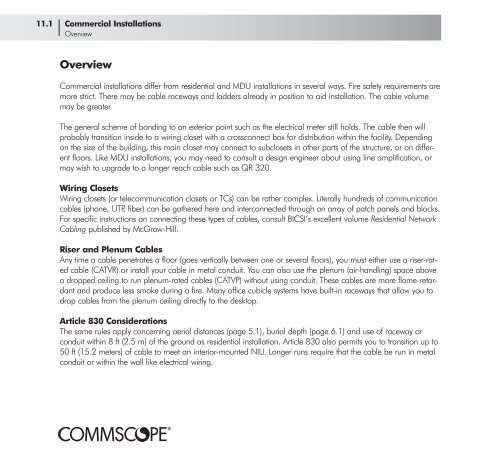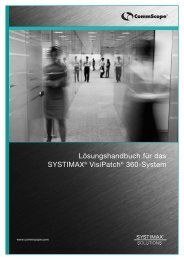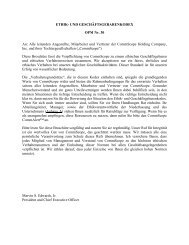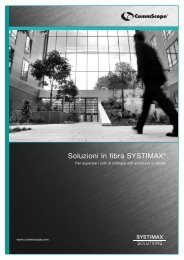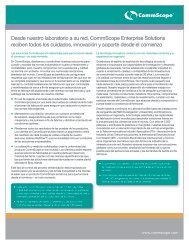Broadband Applications & Construction Manual - Public - CommScope
Broadband Applications & Construction Manual - Public - CommScope
Broadband Applications & Construction Manual - Public - CommScope
Create successful ePaper yourself
Turn your PDF publications into a flip-book with our unique Google optimized e-Paper software.
11.1 Commercial Installations<br />
Overview<br />
Overview<br />
Commercial installations differ from residential and MDU installations in several ways. Fire safety requirements are<br />
more strict. There may be cable raceways and ladders already in position to aid installation. The cable volume<br />
may be greater.<br />
The general scheme of bonding to an exterior point such as the electrical meter still holds. The cable then will<br />
probably transition inside to a wiring closet with a crossconnect box for distribution within the facility. Depending<br />
on the size of the building, this main closet may connect to subclosets in other parts of the structure, or on different<br />
floors. Like MDU installations, you may need to consult a design engineer about using line amplification, or<br />
may wish to upgrade to a longer reach cable such as QR 320.<br />
Wiring Closets<br />
Wiring closets (or telecommunication closets or TCs) can be rather complex. Literally hundreds of communication<br />
cables (phone, UTP, fiber) can be gathered here and interconnected through an array of patch panels and blocks.<br />
For specific instructions on connecting these types of cables, consult BICSI’s excellent volume Residential Network<br />
Cabling published by McGraw-Hill.<br />
Riser and Plenum Cables<br />
Any time a cable penetrates a floor (goes vertically between one or several floors), you must either use a riser-rated<br />
cable (CATVR) or install your cable in metal conduit. You can also use the plenum (air-handling) space above<br />
a dropped ceiling to run plenum-rated cables (CATVP) without using conduit. These cables are more flame-retardant<br />
and produce less smoke during a fire. Many office cubicle systems have built-in raceways that allow you to<br />
drop cables from the plenum ceiling directly to the desktop.<br />
Article 830 Considerations<br />
The same rules apply concerning aerial distances (page 5.1), burial depth (page 6.1) and use of raceway or<br />
conduit within 8 ft (2.5 m) of the ground as residential installation. Article 830 also permits you to transition up to<br />
50 ft (15.2 meters) of cable to meet an interior-mounted NIU. Longer runs require that the cable be run in metal<br />
conduit or within the wall like electrical wiring.


